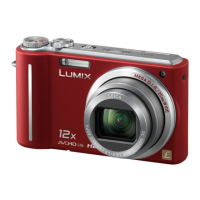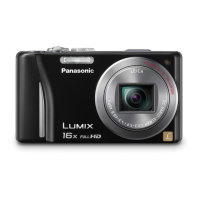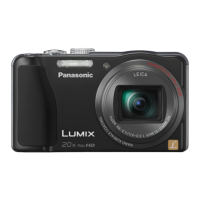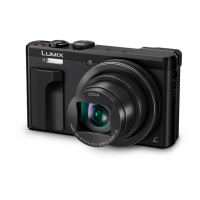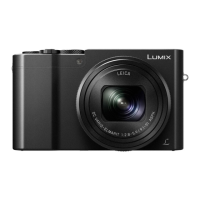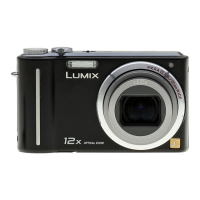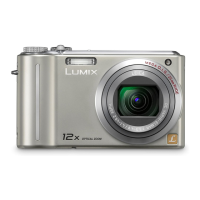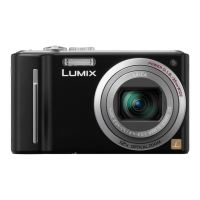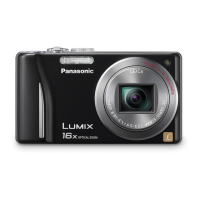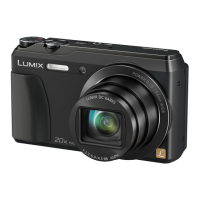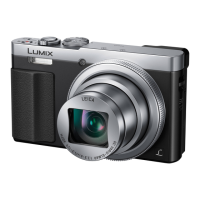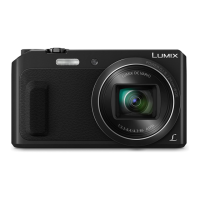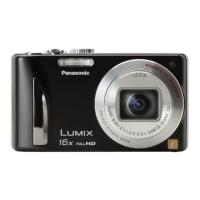
Do you have a question about the Panasonic Lumix DMC-ZS15 and is the answer not in the manual?
| Brand | Panasonic |
|---|---|
| Model | Lumix DMC-ZS15 |
| Category | Digital Camera |
| Language | English |
Advice on how to handle the camera to avoid damage from force, vibration, dust, and water.
Guidance on managing condensation on the lens or LCD monitor due to temperature changes.
Information on optional accessories like memory cards and how to obtain replacement parts.
Details on how to use the cursor button for navigation and selection within menus.
Step-by-step guide for inserting and removing the camera battery safely and correctly.
Details on charging the battery using the AC adapter or a computer via USB.
Explanation of the charging lamp's status and notes on charging time.
How to check the remaining battery level and when to recharge or replace.
Estimated number of still pictures and recording time under CIPA standard conditions.
Estimated recording time for motion pictures in AVCHD and MP4 formats.
Information on using built-in memory and compatible memory card types.
Estimated remaining pictures or recording time based on memory capacity.
Table showing picture count based on resolution and memory card size.
Table showing recording time based on quality and memory card size.
Procedure to change the date and time settings after the initial setup.
Explanation of how to select and use different recording modes like Intelligent Auto and Program AE.
How to aim, shoot, and properly hold the camera to prevent shake and ensure good results.
Steps for viewing pictures and turning off the camera.
How to change the information displayed on the LCD screen during recording.
How flash functions automatically in Intelligent Auto mode and related settings.
Using Motion Deblur to minimize subject blur by adjusting shutter speed automatically.
Using iHDR to combine exposures for a picture with richer gradation.
How to use AF Tracking to maintain focus on a moving subject.
Information on playback compatibility of recorded motion pictures with various devices.
Using the burst function to capture multiple still shots during motion picture recording.
How to change the information displayed on the LCD screen during recording.
Viewing multiple pictures simultaneously in a list format.
How to delete multiple pictures at once or all pictures from the camera.
Overview of the different menus available ([Rec], [Motion Picture], [Setup], etc.) and their purposes.
How to quickly access and adjust frequently used menu items using the Q.MENU button.
Configuring the clock, world time, and travel dates for accurate recording.
Adjusting beep levels, beep tones, shutter volume, and shutter tones.
Adjusting speaker volume and registering custom camera settings.
Settings for adjusting LCD display brightness, color, and mode for better visibility.
Using guide lines for composition and histogram for exposure analysis.
Setting video recording area display and remembering zoom position after power off.
Using Economy and LCD Power Save modes to conserve battery life.
Configuring how pictures are displayed immediately after being taken.
Resetting picture file numbers and restoring default camera settings.
Selecting the communication method for connecting the camera to a computer or printer.
Changing TV aspect ratio and enabling VIERA Link for device control.
Setting the output mode for 3D still pictures.
Automatically rotating pictures and viewing camera firmware version.
Formatting the built-in memory or memory card to erase all data.
Changing the display language and viewing a demonstration of camera functions.
Details on optical zoom range and extended optical zoom features.
Using i.ZOOM for quality preservation and digital zoom for increased magnification.
Table showing flash availability across different shooting modes.
Information on shutter speeds used with different flash modes.
Understanding the minimum focus distances for close-up shots with different zoom and macro settings.
Using Auto Bracket to automatically take multiple shots with varying exposures.
Controlling depth of field by setting aperture priority.
Controlling motion blur by setting shutter speed priority.
How to change selected picture effects within the Creative Control menu.
Optimizing settings for portraits and smoothing skin tones.
Taking clear wide shots and creating panoramic images.
Tips and important notes for successful panorama shooting and playback.
Settings for capturing fast action and portraits in low light conditions.
Capturing clear night scenes and handheld shots with reduced jitter.
Using HDR for better gradation and Food mode for natural food pictures.
Recording age and name for babies and pets, with specific shooting tips.
Capturing sunsets, dark scenes, and shots through glass.
Tips for taking natural color pictures in an underwater environment.
How to select and use registered custom settings via the mode dial and menus.
Information on picture size settings and limitations for burst shooting.
Tips for taking clear face pictures to register for accurate recognition.
Procedure for setting departure/return dates and locations for travel logging.
Setting world time for different destinations and managing summer time.
Changing the aspect ratio of still pictures for printing or playback.
Selecting the resolution (pixel count) for still pictures.
Adjusting the quality level of still pictures and ISO sensitivity.
Adjusting white balance to ensure accurate colors under different lighting.
Procedure for manually setting white balance for precise color accuracy.
Choosing the autofocus mode for optimal focus based on subject and conditions.
Using Quick AF for faster focus adjustment, even without pressing the shutter button.
Selecting metering modes and adjusting contrast for lifelike colors.
Setting minimum shutter speed and using intelligent resolution for sharper images.
Using digital zoom and understanding burst settings.
Selecting color effects and using the AF assist lamp for focus.
Automatically detecting and correcting red-eye and using image stabilization.
Adding date and time stamps to still pictures and setting the clock.
Setting the picture quality (resolution, bit rate, fps) for motion pictures.
Keeping focus constant and reducing wind noise during video recording.
Switching playback between 2D and 3D formats for 3D pictures.
Configuring automatic playback of pictures with music and effects.
Applying effects, duration, and sound settings for slideshows.
Narrowing down pictures by category or favorites and viewing by date.
Using Auto Retouch to automatically enhance image quality.
Applying various creative effects to retouch recorded still pictures.
Selecting pictures for uploading to image-sharing websites like Facebook or YouTube.
Adding titles or text to favorite still pictures.
Adding various text information like date, name, or location to pictures.
Splitting motion pictures into two parts to keep desired scenes or save space.
Reducing the size and cropping unwanted areas of still pictures.
Labeling favorite pictures with a star for selective playback or deletion.
Setting print options like date, number of copies, and page layout for printers.
Protecting pictures from deletion and editing face recognition data.
Copying pictures between the camera's built-in memory and a memory card.
Instructions for connecting the camera to a TV using HDMI or AV cables.
Important notes and limitations when connecting via HDMI cable.
Notes on using AV cables for TV connection, including picture rotation.
Playing back pictures directly from an SD card on compatible TVs.
Explanation of VIERA Link for integrated control of compatible devices.
Steps for setting up and using VIERA Link for TV viewing.
Copying pictures directly from the SD card to compatible recording devices.
Transferring video content to external media using AV cables for dubbing.
Step-by-step instructions for connecting the camera to a computer via USB.
Understanding how pictures are organized into folders and named on a computer.
Using the LUMIX Image Uploader tool to upload pictures to websites.
Selecting multiple pictures for batch printing using camera settings.
Configuring print settings like date, number of prints, and page layout on the camera.
Adding date and text information during printing via store or computer.
Explanation of icons and information displayed on the LCD monitor during playback.
Troubleshooting common problems related to battery charging and power.
Solutions for blurred pictures, interference, and motion picture recording issues.
Troubleshooting problems with the LCD monitor's brightness, flickering, or display distortion.
Troubleshooting problems with viewing pictures, folder display, and date accuracy.
Resolving issues related to connecting the camera to TVs, computers, or printers.
Solutions for issues related to language, camera noises, heat, and zoom.
Precautions for handling memory cards and advice on battery charging.
Care instructions for the AC adapter, camera lens, and safety for 3D viewing.
